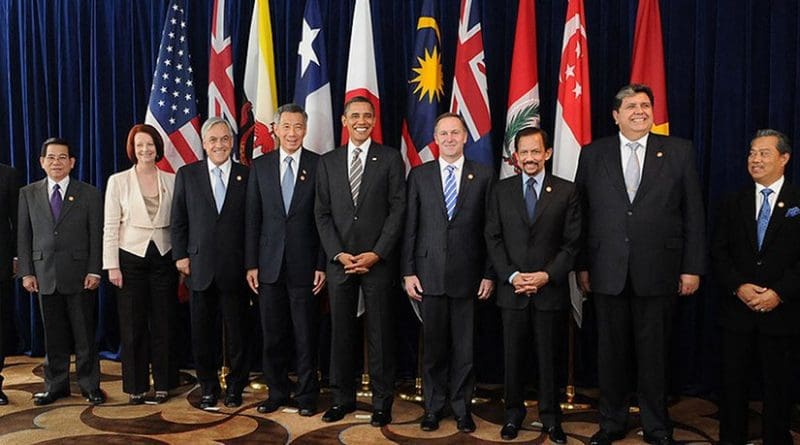TPP12 Vs TPP11: Gainers And Losers – Analysis
By RSIS
Our simulation of an econometric model suggests that the net benefit of TPP11 is positive. There is, therefore, a case for going ahead with TPP11.
By Pradumna Bickram Rana and Ji Xianbai*
The Trans-Pacific Partnership among 12 nations (TPP12) was thrown into disarray after President Donald Trump pulled the United States, the largest economy in the grouping, out of what was to be a landmark trade deal. Presently, a number of remaining TPP members including Australia, New Zealand, Chile and Singapore are making the case for a trade pact without the US, dubbed TPP11 or “TPP 12 minus one”.
The advocates of TPP11 are proposing to keep the deal alive not only because it would be tragic to abandon a historic agreement produced after almost a decade of intense multi-country negotiations. But it is also because the TPP was a modern, comprehensive and high-standard trade deal that could bring substantial economic benefits to participating countries even without the US.
The Gainers
Which countries would be the gainers and losers with the move from TPP12 to TPP11? To answer this question we simulated the two scenarios using the advanced Global Trade Analysis Project (GTAP) model which we have modified for our on-going research on free trade agreements (FTAs). Our modelling results suggest that there will be two types of gainers.
The first are the countries that already have an FTA with the US either multilaterally or bilaterally. Canada and Mexico that are members of the North American Free Trade Agreement (NAFTA) together with the US will be better off economically under TPP11 rather than TPP12.
Besides, the four TPP countries which already have bilateral FTAs with the US – Australia, Chile, Peru and Singapore – will also gain more under the TPP11. This is partly because, since the TPP12 deal did not go through, the US cannot extend similar preferential market access to firms from other would-be member countries.
The second type of gainers from the move to TPP11 are the countries that were to be excluded from the TPP12. In general, FTAs create trade between contracting parties while diverting trade away from non-member countries. Under TPP12, the GDP of major countries like China, India and the European Union (EU) was estimated to contract by about 0.2 per cent each. These countries will gain under TPP11 because their economic outputs will shrink by less.
The Losers
Similarly, there are two types of losers from the US’ exit from TPP12. The most significant loser is the US itself. The US was expected to be the largest beneficiary of TPP12 in dollar terms, but TPP11 could lead to a contraction of its GDP by 0.2 per cent. President Trump’s decision to withdraw from TPP12 could save some jobs in the manufacturing and extractive industries, but these will be more than offset by job losses in the agricultural and the services sectors of the US.
Countries that had hoped to establish privileged trading relations with the US and to lock-in structural reforms domestically through TPP12, would also lose under TPP11. These include Japan, Malaysia and Vietnam where the estimated gains from TPP11 are 0.5 per cent, 0.4 per cent, and 1.1 per cent of GDP respectively. These gains, although lower than those from TPP12, are still welcome during this on-going period of global trade slowdown and economic uncertainty.
The Next Steps
On the whole, it is in the interest of the remaining TPP countries to retain the deal and press ahead with TPP11. Our estimates show that the net benefit of TPP11 to all its members is 0.4 per cent of their combined GDP. TPP11 also adds some US$5 billion to global welfare according to our simulation results.
Then what are the next steps that should be taken in negotiating and implementing TPP11? First, the TPP12 agreement signed in early 2016 should not be altered too much by TPP11 countries so that it can be implemented smoothly and expeditiously. This means that, among others, it would be unwise to consider the expansion of membership to countries like Indonesia and China as suggested by some. This is because the TPP’s tariff elimination schedules are country- as well as partner-specific and inviting new members at this point in time would re-open the painstaking negotiating process and cause further delays.
Second, when proceeding with TPP11, members should leave open the option of the US re-joining the pact at a later stage. This is because the US has more to lose from withdrawing from TPP11 than any other country. Since the 1980s, the US economy had opened up to the point where four-fifths of the imports that originated in TPP countries crossed the US border duty-free, while “Made-in-America” products are subject to more than 18,000 taxes and behind-the-border obstacles in TPP partner countries. Pro-US provisions that the Obama administration had negotiated into TPP12 would have levelled the playing field for US businesses.
Third, government agencies and business associations alike in TPP11 countries should provide institutional support (e.g. information dissemination, training and technical consultation) to domestic firms so that they can make fuller and better utilisation of the negotiated TPP preferences. Asia’s small and medium sized enterprises often fail to grasp the benefits of preferential trading arrangements available to them in the absence of tailored support.
The eleven countries in the proposed TPP11 should, therefore, initiate actions to resurrect the most ambitious trading arrangement that the world has ever planned and stay the course in cultivating a transparent, rules-based trading architecture in the fast growing Asia-Pacific region. Even without the US, TPP11 still has much to offer.
*Pradumna B. Rana is Associate Professor and Coordinator of the International Political Economy Programme at the S. Rajaratnam School of International Studies (RSIS), Nanyang Technological University, Singapore. Ji Xianbai is a PhD candidate at RSIS and Europa Fellow at the Australian National University.

